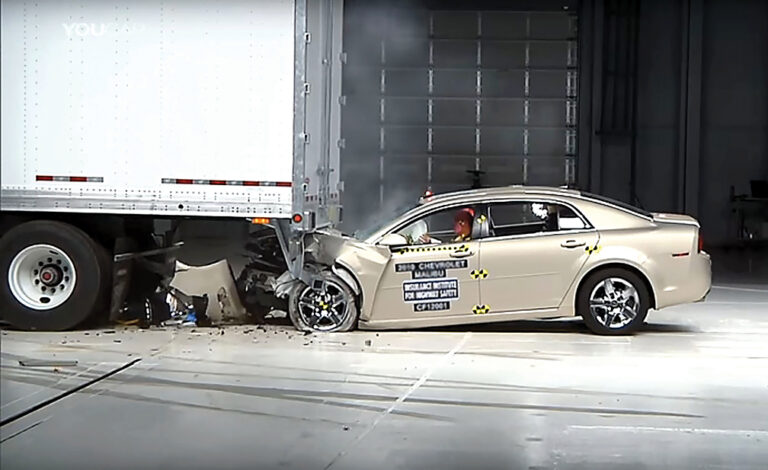The National Highway Traffic Safety Administration (NHTSA) has finalized a rule that updates two Federal Motor Vehicle Safety Standards related to underride crashes.
This rule, along with increased research and the creation of an advisory committee on underride protection, is the result of President Joe Biden’s Bipartisan Infrastructure Law and is a part of the U.S. Department of Transportation’s (USDOT) 2022 National Roadway Safety Strategy.
The rule requires that trailers and semi-trailers be equipped with rear impact guards that have sufficient strength and energy absorption to protect occupants of passenger vehicles in multiple crash scenarios.
But not everyone is happy about it.
Some say it doesn’t do enough to protect smaller vehicles in crashes with big rig trailers.
“The result of the rulemaking process, which was initiated in 2015, is a completely inadequate standard that will make road users less safe and undermines the Biden administration’s stated goal of working towards zero roadway deaths,” according to a statement from the Advocates for Highway and Auto Safety (AHAS).
Rear underride crashes, which are often deadly, occur when the front end of a vehicle crashes into the back of a larger vehicle, such as a large trailer or semi-trailer, and slides under that vehicle. In 2019, 531 of the 2,132 passenger vehicle occupants killed in two-vehicle crashes involving a large truck died when their vehicles struck the rear of a large truck.
While some trucking organizations, such as the Owner-Operator Independent Drivers Association (OOIDA), are opposed to the new rule, others are in support of it.
The Truckload Carriers Association (TCA), for example, supports rear underride guard legislation.
“The reality is that the strengthened equipment is already in place pre-regulation so, those who purchase new trailers are likely getting the reinforced guard already, a great example of how industry is well ahead of the curve when it comes to equipment improvements and regulations,” said TCA Senior Vice President of Safety and Government Affairs David Heller.
While OOIDA and others contend that requiring underride guards can be a financial burden on truckers and carriers, Heller disagrees.
“(It’s) not really a financial burden, as the trailers are already spec’d out to those standards,” he said. “Even with the new rule on rear guards, the standard has already been in place — so the financial burden is minimal at this point.”
For decades, AHAS officials have urged the adoption of comprehensive underride guard safety standards to prevent fatalities and injuries resulting from deadly collisions.
“Advocates for Highway and Auto Safety is deeply disappointed that nearly seven years after the notice of proposed rulemaking on truck rear underride guards was issued, the National Highway Traffic Safety Administration released a rule that is substantially weaker than the current test the Insurance Institute for Highway Safety has been using to rate rear underride guards for the last five years, especially considering nine major trailer manufacturers meet it,” shared AHAS President Cathy Chase.
“Unfortunately, (this) action allows trucking companies to choose a less safe course of action at the expense of road user safety,” she continued. “With large truck fatalities on the rise, the agency responsible for the safety of our nation’s roads needs to be taking action to improve, not imperil, protections for road users.”
Joan Claybrook, a former NHTSA administrator, said the final rule on rear underride guards “amounts to nothing less than regulatory malpractice. It would have been better if NHTSA had not acted at all. Instead of improving protections to reduce underride fatalities and injuries, the agency has gone backward by issuing a rule that 94% of trailers already meet. As such, NHTSA has lowered the bar on public safety instead of ensuring it. This is an affront to the families of underride victims who have been working so hard to have the standard updated.”
NHTSA Administrator Steven Cliff says his agency’s priority is making roads safe for everyone.
“This new rule will improve protection for passengers and drivers of passenger vehicles while also meeting a critical mandate from Congress under the Bipartisan Infrastructure Law,” he stated.
In addition, NHTSA is implementing a number of other underride provisions of the Bipartisan Infrastructure Law, including:
- Establishing a federal advisory committee on underride protection, which will complete research on side underride guards for trailers and semi-trailers to assess their effectiveness, feasibility, benefits, costs, and impact on intermodal operations.
- Planning to publish an advance notice of proposed rulemaking to consider requirements for side underride guards for crashes into the sides of trailers and semi-trailers. This rulemaking also responds to a provision in the Bipartisan Infrastructure Law to report the findings of research on side underride guards in a Federal Register notice to seek public comment.
- Improving data collection of underride crashes by recommending inclusion of underride data in state crash data systems and by providing educational materials to state and local police departments on identifying and recording underride crashes.
- Conducting research on rear impact guard designs that better protect occupants of passenger vehicles in even more rear underride crash scenarios.
As for the proposed NHTSA study on side underride guards, Heller said, that’s an entirely different aspect.
“First and foremost, I think it is worthwhile to mention that TCA supports accident prevention technology in an effort to eliminate the accidents from ever happening in the first place,” he noted. “Side underride guards, while still in the experimental stage, do not prevent the accidents from happening. I know that there are still trials ongoing that are testing these devices to examine the road worthiness and ability to withstand impacts at greater speeds and different angles of impact.”
The overall effectiveness and durability of underride guards remains to be seen.
“Questions continue to remain regarding additional weight on the trailer and its effect on freight, how well the devices will hold up on the roads and even the flexibility to adapt the equipment when it comes to sliding rear axles, just to name a few,” Heller said.
“But as an industry and highway user that shares the road with everyone, I think technology, such as AEB (automatic emergency braking), would go farther in preventing the accident from ever happening than any side guard would and perhaps a regulation that would require this technology on all vehicles would be more beneficial,” he concluded.
Linda Garner-Bunch has been with The Trucker since 2020, picking up the reins as managing editor in 2022. Linda has nearly 40 years of experience in the publishing industry, covering topics from the trucking and automotive industry to employment, real estate, home decor, crafts, cooking, weddings, high school sports — you name it, she’s written about it. She is also an experienced photographer, designer and copy editor who has a heartfelt love for the trucking industry, from the driver’s seat to the C-suite.















